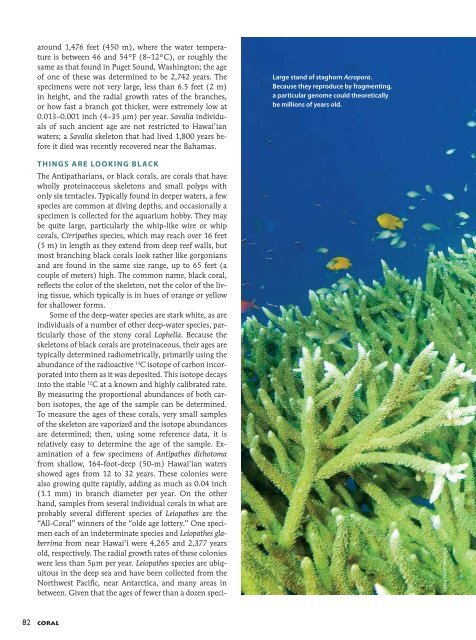Create successful ePaper yourself
Turn your PDF publications into a flip-book with our unique Google optimized e-Paper software.
around 1,476 feet (450 m), where the water temperature<br />
is between 46 and 54°F (8–12°C), or roughly the<br />
same as that found in Puget Sound, Washington; the age<br />
of one of these was determined to be 2,742 years. The<br />
specimens were not very large, less than 6.5 feet (2 m)<br />
in height, and the radial growth rates of the branches,<br />
or how fast a branch got thicker, were extremely low at<br />
0.013–0.001 inch (4–35 μm) per year. Savalia individuals<br />
of such ancient age are not restricted to Hawai’ian<br />
waters; a Savalia skeleton that had lived 1,800 years before<br />
it died was recently recovered near the Bahamas.<br />
Large stand of staghorn Acropora.<br />
Because they reproduce by fragmenting,<br />
a particular genome could theoretically<br />
be millions of years old.<br />
THINGS ARE LOOKING BLACK<br />
The Antipatharians, or black corals, are corals that have<br />
wholly proteinaceous skeletons and small polyps with<br />
only six tentacles. Typically found in deeper waters, a few<br />
species are common at diving depths, and occasionally a<br />
specimen is collected for the aquarium hobby. They may<br />
be quite large, particularly the whip-like wire or whip<br />
corals, Cirripathes species, which may reach over 16 feet<br />
(5 m) in length as they extend from deep reef walls, but<br />
most branching black corals look rather like gorgonians<br />
and are found in the same size range, up to 65 feet (a<br />
couple of meters) high. The common name, black coral,<br />
reflects the color of the skeleton, not the color of the living<br />
tissue, which typically is in hues of orange or yellow<br />
for shallower forms.<br />
Some of the deep-water species are stark white, as are<br />
individuals of a number of other deep-water species, particularly<br />
those of the stony coral Lophelia. Because the<br />
skeletons of black corals are proteinaceous, their ages are<br />
typically determined radiometrically, primarily using the<br />
abundance of the radioactive 14 C isotope of carbon incorporated<br />
into them as it was deposited. This isotope decays<br />
into the stable 12 C at a known and highly calibrated rate.<br />
By measuring the proportional abundances of both carbon<br />
isotopes, the age of the sample can be determined.<br />
To measure the ages of these corals, very small samples<br />
of the skeleton are vaporized and the isotope abundances<br />
are determined; then, using some reference data, it is<br />
relatively easy to determine the age of the sample. Examination<br />
of a few specimens of Antipathes dichotoma<br />
from shallow, 164-foot-deep (50-m) Hawai’ian waters<br />
showed ages from 12 to 32 years. These colonies were<br />
also growing quite rapidly, adding as much as 0.04 inch<br />
(1.1 mm) in branch diameter per year. On the other<br />
hand, samples from several individual corals in what are<br />
probably several different species of Leiopathes are the<br />
“All-Coral” winners of the “olde age lottery.” One specimen<br />
each of an indeterminate species and Leiopathes glaberrima<br />
from near Hawai’i were 4,265 and 2,377 years<br />
old, respectively. The radial growth rates of these colonies<br />
were less than 5μm per year. Leiopathes species are ubiquitous<br />
in the deep sea and have been collected from the<br />
Northwest Pacific, near Antarctica, and many areas in<br />
between. Given that the ages of fewer than a dozen speci-<br />
CBPIX/SHUTTERSTOCK<br />
82 CORAL

















